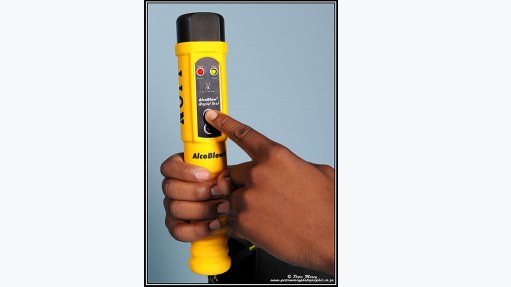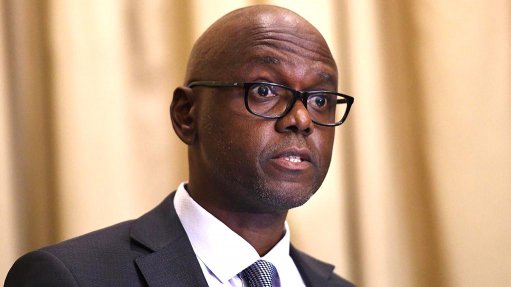South Africa needs 13 GW of gas-to-power capacity – more than the IRP envisions

Standard Bank head of Southern Africa’s oil and gas coverage Paul Eardley-Taylor discusses the need for increased gas-to-power capacity in South Africa's energy mix. Video and editing: Shadwyn Dickinson
Standard Bank head of Southern Africa’s oil and gas coverage Paul Eardley-Taylor has suggested that South Africa needs 13 GW of gas-to-power (GtP) capacity, rather than the 7.2 GW to 8.6 GW outlined in the draft Integrated Resource Plan 2023.
Speaking at mine ventilation solutions developer Howden’s Technology Day, hosted at Mintek, in Johannesburg, on April 17, he explained that this calculation was made by considering the need to overcome Stage 6 or even Stage 7 loadshedding, when Stage 6 was being regularly achieved, as well as ensure a 15% reserve margin for winter peak demand.
He said 13 GW of GtP would enable Eskom to comfortably undertake regular maintenance of its coal fleet over the long term, while effectively alleviating any loadshedding risk.
He said there was little doubt that the Southern African region had significant hydrocarbons, most likely including South Africa, which ought to be responsibly developed for economic growth, fiscal benefit and GtP.
He said that, considering the low levelised cost of energy (LCOE) to produce wind and solar photovoltaic (PV) energy, Eardley-Taylor said the implementation of additional renewable energy capacity should be carried out when economically viable.
However, he stressed that it was a mistake to solely use the LCOE when making electricity procurement decisions, as it does not reflect renewable energy intermittency challenges.
Rather, the full cost of energy (FCOE), including other power sources used when renewable energy was not producing, along with incremental transmission investments, should be assessed among other considerations.
“The scale of the problem increases as more renewable energy is added to the grid. Flexible dispatchable power, like GtP, is required to mitigate intermittency and provide supply stability,” he explained.
He noted that gas price volatility was periodically raised as a challenge to the roll-out of significant GtP capacity in South Africa, and elsewhere in Africa. He pointed out that spikes in the gas price in 2022, exacerbated by the rand’s weakness, were cited as drivers of the cost of GtP being too high, particularly when compared to the LCOE of wind and solar PV.
Eardley-Taylor said that, while the LCOE metric alone was not sufficient to decide on a generation technology choice, he cited two possible LCOE scenarios for liquefied natural gas (LNG) to be used for GtP. He said these two scenarios were differentiated according to coastal and inland scenarios, owing to South Africa’s topography.
Coastal locations for LNG GtP development imply higher plant output at low altitude but require significant capital expenditure for new substation and grid connection infrastructure, except for perhaps Richards Bay and Avon, where this infrastructure is already in place. However, power line transmission losses would be significant.
The inland scenario sees Mpumalanga as an LNG GtP generation location. Eardley-Taylor noted that, locations at higher altitudes could negatively impact GtP output by about 15%. However, these losses could be offset by the fact that it was closer to existing substation and grid connection infrastructure and closer to load centres.
He said that Standard Bank’s ballpark LCOE for LNG GtP into baseload combined-cycle gas turbines across the coastal scenario was about R1.50/kWh to R1.55/kWh in 2023 financial terms.
When South African carbon taxes are factored in, the inland scenario ends up being about 10c/kWh more expensive.
However, Eardley-Taylor cautioned that these results were very sensitive to assumed gas prices and foreign exchange rates, but that diesel costs were equally sensitive to the same, and that loadshedding cost at least ten times this amount in diesel.
He pointed out that in the 2022/23 financial year, Eskom spent, on average, R7.59/kWh on diesel for its own and procured open cycle gas turbine peaking plants, including independent power producer capacity charges.
Eardley-Taylor contrasted this with the LNG to baseload GtP LCOE expectations. He added that, if the 11B and 12B discoveries – otherwise known as Luiperd and Brulpadda – could be developed, they would pay tax to South Africa on gas earnings, which would see the baseload LCOE reduce further down to about R1.10/kWh.
However, until South Africa got these projects off the ground, which could take anywhere from 10 to 20 years from discovery to production, Eardley-Taylor said South Africans would need to look to its neighbours to supply its gas demand.
MOZAMBIQUE
“The current expectation we have is that the first four projects of Mozambique are going to be larger than the projects that were expected in 2019 - about 38-million tons of LNG as opposed to 31-million tons of LNG,” he said.
In Mozambique, Eardley-Taylor said that he expected Pande Temane production to decrease by 10%/y from 2026 to 2028. As production declined, so would the allocation for Sasol, which meant that securing alternative supply was critical. Pande Temane production was expected to meet 40 MJ/y of local demand at first.
However, Eardley-Taylor highlighted the Matola project, with the assumed Matola floating storage regasification unit (FSRU) capacity being four-million tonnes a year throughput, or 212 MJ/y, to balance the increased South African demand in light of Pande Temane decline. Moreover, the Matola port had the capacity to accommodate two FSRUs in future.
“Stage six loadshedding on its own can be solved by Matola. The likelihood is that Matola will be fully contracted within a couple of years,” Eardley-Taylor said.
Eardley-Taylor noted that Sasol’s demand for gas for Secunda, Sasolburg and power feedstock would decrease somewhat, and that the company currently had no plans to buy LNG from the Matola FSRU.
In its August 2023 results, Sasol confirmed that it would no longer supply methane-rich gas to KwaZulu-Natal consumers or natural gas to Gauteng customers from June 2026. This was expected to lead to a Rompco or Lilly pipeline connection being built to ensure supply.
Demand in the Gauteng region from existing users was currently at about 50 GJ, including new industrial demand. However, Eardley-Taylor pointed out that there was the potential for new GtP at existing Eskom coal-fired power sites, where 1 000 MW baseload required about 50 MJ/y, in addition to Richards Bay GtP.
The Rompco pipeline capacity is currently 212 MJ/y, but this can be increased to about 350 MJ/y by debottlenecking and adding additional compressors.
He said there was added potential for LNG imports into Richards Bay or Durban, at a Sapref-based FSRU. Gas could also be used for new GtP, whether through Eskom or independent power producers, near the site or to backfill the Lilly pipeline.
Overall, notwithstanding the region's many problems, Mozambique gas development was continuing, Eardley-Taylor said.
NAMIBIA
Recent discoveries offshore Namibia are estimated to contain about 6-billion to 7.5-billion of recoverable barrels of oil equivalent, according to consultancy Wood Mackenzie.
“That’s equivalent to a production of one-million barrels of oil a day for 20 years. This makes Namibia super exciting,” Eardley-Taylor said.
However, while he noted the significant potential of Namibia to supply South Africa’s West Coast with oil and gas, it remained a long way off.
“If the Namibian discoveries are as we expect, and consequently, if South Africa then starts drilling from next year, which we expect, it's likely that the economic climate of the late 2020s and the prospects for South Africa can be better tomorrow than they are today,” Eardley-Taylor said.
He said that, currently, Namibia was in the midst of a significant period of exploration and appraisal activities, poised to have a substantial impact on the country's potential oil production. These ongoing operations were crucial in determining the individual oil-to-gas ratio for each block, thereby providing a clearer indication of the volumes of associated gas available for production and sale.
Eardley-Taylor said that, to date, Shell had officially confirmed the success of the Graff appraisal and the Jonker-1A appraisal wells, with the Jonker-2A appraisal also now completed. Additionally, TotalEnergies had reported successful appraisals for the Venus 1X and 1A wells.
He noted that Namibia’s Petroleum Commissioner publicly announced in February 2021 that appraisal reports from operators would start to be received from April 2024 onwards.
Looking ahead to the upcoming months, Eardley-Taylor said several significant developments were expected.
In February, TotalEnergies announced the discovery of hydrocarbons in the Mangetti-1X exploration well, spanning both the Mangetti and North Venus target areas. Appraisal of this find was expected in the near future. Further, TotalEnergies was presently drilling the Venus 2-A well, with further updates expected by the end of the first quarter.
Additionally, Shell had recently started drilling activities for the Enigma-1X exploration well.
A pivotal discovery was made on January 10 by Galp, confirming the success of the Mopane-1X exploration well, uncovering a "significant column of light oil." This marks the third major find by operators. Galp further announced on February 14 that the Mopane-2X well also encountered a light oil column, with plans for the appraisal of Mopane-1X expected this month.
Considering the broader perspective for Namibia, Eardley-Taylor noted that there arose the potential for significant proposals, especially in light of the numerous discoveries to date.
Among these possibilities was the proposal for a larger offshore gas pipeline from Kudu, possibly an 18-inch line, to facilitate faster transportation of landed gas.
Additionally, there is the possibility of long-term plans for an offshore gas processing hub centred in the Kudu region.
With the potential for at least seven appraisal wells to be drilled by mid-year, the overall risk profile of Namibia's oil and gas sector could see significant mitigation. This, in turn, could pave the way for the post-oil final investment decision development of a shared Namibia LNG initiative.
Comments
Press Office
Announcements
What's On
Subscribe to improve your user experience...
Option 1 (equivalent of R125 a month):
Receive a weekly copy of Creamer Media's Engineering News & Mining Weekly magazine
(print copy for those in South Africa and e-magazine for those outside of South Africa)
Receive daily email newsletters
Access to full search results
Access archive of magazine back copies
Access to Projects in Progress
Access to ONE Research Report of your choice in PDF format
Option 2 (equivalent of R375 a month):
All benefits from Option 1
PLUS
Access to Creamer Media's Research Channel Africa for ALL Research Reports, in PDF format, on various industrial and mining sectors
including Electricity; Water; Energy Transition; Hydrogen; Roads, Rail and Ports; Coal; Gold; Platinum; Battery Metals; etc.
Already a subscriber?
Forgotten your password?
Receive weekly copy of Creamer Media's Engineering News & Mining Weekly magazine (print copy for those in South Africa and e-magazine for those outside of South Africa)
➕
Recieve daily email newsletters
➕
Access to full search results
➕
Access archive of magazine back copies
➕
Access to Projects in Progress
➕
Access to ONE Research Report of your choice in PDF format
RESEARCH CHANNEL AFRICA
R4500 (equivalent of R375 a month)
SUBSCRIBEAll benefits from Option 1
➕
Access to Creamer Media's Research Channel Africa for ALL Research Reports on various industrial and mining sectors, in PDF format, including on:
Electricity
➕
Water
➕
Energy Transition
➕
Hydrogen
➕
Roads, Rail and Ports
➕
Coal
➕
Gold
➕
Platinum
➕
Battery Metals
➕
etc.
Receive all benefits from Option 1 or Option 2 delivered to numerous people at your company
➕
Multiple User names and Passwords for simultaneous log-ins
➕
Intranet integration access to all in your organisation



















